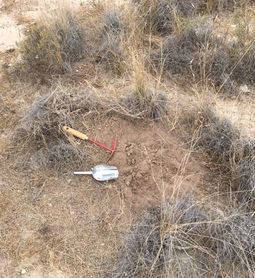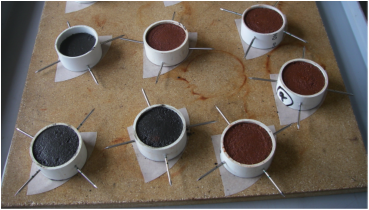Plant-microbe interactions

Resource partitioning between soil microbial communities
Soil microbial nutrient cycling has a direct link to plant health. Understanding nutrient partitioning between different functional guilds of soil microbes is important to devise effective management practises to enhance crop productivity or plant establishment (in restoration). Using isotope-based analysis, we are studying the how microorganisms partition nutrients in the environment, particularly in soil without any anthropogenic influence
Lab Member: Mark Cunningham (DfE-PhD student)
Collaborator
Dr Miriam Munoz-Rojas, University of New South Wales
Photo: Courtesy Dr Miriam Munoz-Rojas
Soil microbial nutrient cycling has a direct link to plant health. Understanding nutrient partitioning between different functional guilds of soil microbes is important to devise effective management practises to enhance crop productivity or plant establishment (in restoration). Using isotope-based analysis, we are studying the how microorganisms partition nutrients in the environment, particularly in soil without any anthropogenic influence
Lab Member: Mark Cunningham (DfE-PhD student)
Collaborator
Dr Miriam Munoz-Rojas, University of New South Wales
Photo: Courtesy Dr Miriam Munoz-Rojas

Rehabilitation of post-mining substrates
Mining of mineral resources (such as iron ore, copper and nickel) has been an integral part in the global history of social and economic development. Mine operators are legally obligated to restore the extraction site as specified by the local government’s environmental regulation. Establishment of rehabilitated landforms using post-mining substrates (i.e. waste rocks, tailings) that typically exhibit extreme conditions (such as high pH, nutrient deficiency, excessive salinity and metal toxicity) can be a major issue during mine closure operations. Current mine rehabilitation strategies focus upon the establishment of above ground diversity (i.e 60-80% of the plant taxa in an adjacent reference site), which are the primary indicators for successful rehabilitation. Poor establishment of plant growth and diversity can lead to other complications such as impaired landform stability and accelerated erosion. Despite the wide acknowledgement on the impact of microbial functional diversity on overall soil health and plant diversity, no detailed attention has been paid to understand the role of microbes in mine rehabilitation strategies. In this project we attempt to incorporate the role of microbes into successful rehabilitation strategies. We are also exploring the possibility to use microbial community composition as a potential indicator in rehabilitation of post-mining substrates.
Mining of mineral resources (such as iron ore, copper and nickel) has been an integral part in the global history of social and economic development. Mine operators are legally obligated to restore the extraction site as specified by the local government’s environmental regulation. Establishment of rehabilitated landforms using post-mining substrates (i.e. waste rocks, tailings) that typically exhibit extreme conditions (such as high pH, nutrient deficiency, excessive salinity and metal toxicity) can be a major issue during mine closure operations. Current mine rehabilitation strategies focus upon the establishment of above ground diversity (i.e 60-80% of the plant taxa in an adjacent reference site), which are the primary indicators for successful rehabilitation. Poor establishment of plant growth and diversity can lead to other complications such as impaired landform stability and accelerated erosion. Despite the wide acknowledgement on the impact of microbial functional diversity on overall soil health and plant diversity, no detailed attention has been paid to understand the role of microbes in mine rehabilitation strategies. In this project we attempt to incorporate the role of microbes into successful rehabilitation strategies. We are also exploring the possibility to use microbial community composition as a potential indicator in rehabilitation of post-mining substrates.